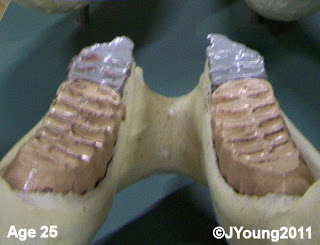 Internal organs: The Brain The brain of an adult elephant is the largest of any land mammal and weighs 4-6 kg. This is about 0.1% of its entire body mass. Although human brains are a lot lighter (about 1.5 kg), they make up a greater proportion of body weight (2%). The temporal lobes, known to function as memory centres are quite large in elephants. Like humans, elephant babies have much smaller brains than those of adults. In most mammals a new-born brain is around 90% of the size of an adult's. In elephants it is 35% and in humans 26%. This probably explains the remarkable learning ability of young elephants.
Internal organs: The Brain The brain of an adult elephant is the largest of any land mammal and weighs 4-6 kg. This is about 0.1% of its entire body mass. Although human brains are a lot lighter (about 1.5 kg), they make up a greater proportion of body weight (2%). The temporal lobes, known to function as memory centres are quite large in elephants. Like humans, elephant babies have much smaller brains than those of adults. In most mammals a new-born brain is around 90% of the size of an adult's. In elephants it is 35% and in humans 26%. This probably explains the remarkable learning ability of young elephants.  Stomach Only about 44% of the food that an elephant eats is successfully digested. The rest is excreted - take a close look at some elephant dung and you will see undigested grass, seeds and other plant matter. Elephants eat for around 16 hours a day and a large bull needs about 300 kg of food each day.
Stomach Only about 44% of the food that an elephant eats is successfully digested. The rest is excreted - take a close look at some elephant dung and you will see undigested grass, seeds and other plant matter. Elephants eat for around 16 hours a day and a large bull needs about 300 kg of food each day.  Heart An elephant heart can weigh anything from 12 to 28 kgs but amounts to only about 0.5% of the animal's body weight. It has a unique shape with two, rather than one, points. The heart beats at around 25-30 beats per minute when the animal is standing, increasing slightly when it is lying down. This is much slower than a human heart which averages 70 beats per minute. Some of an elephant's blood vessels can be over 3m long. In order to prevent their collapse, the animal needs to retain a high blood pressure.
Heart An elephant heart can weigh anything from 12 to 28 kgs but amounts to only about 0.5% of the animal's body weight. It has a unique shape with two, rather than one, points. The heart beats at around 25-30 beats per minute when the animal is standing, increasing slightly when it is lying down. This is much slower than a human heart which averages 70 beats per minute. Some of an elephant's blood vessels can be over 3m long. In order to prevent their collapse, the animal needs to retain a high blood pressure.  Intestines The small and large intestines may reach a combined length of 35m. As food works its way through this system, it can take 24 hours to digest a meal. Lungs Elephants take about 4-5 breaths per minute when lying or very calm. This increases to 10 breaths per minute when standing or active (at rest humans take between 12-20 breaths per minute). The lungs attach directly to the chest cavity and to the diaphragm. Unlike other animals (which use pressure changes to breathe in and out), elephants use muscles to inflate and deflate their lungs.
Intestines The small and large intestines may reach a combined length of 35m. As food works its way through this system, it can take 24 hours to digest a meal. Lungs Elephants take about 4-5 breaths per minute when lying or very calm. This increases to 10 breaths per minute when standing or active (at rest humans take between 12-20 breaths per minute). The lungs attach directly to the chest cavity and to the diaphragm. Unlike other animals (which use pressure changes to breathe in and out), elephants use muscles to inflate and deflate their lungs.  Bladder An elephant expels about 50 litres of urine a day. Anus An elephant excretes up to 150 kg of waste a day.
Bladder An elephant expels about 50 litres of urine a day. Anus An elephant excretes up to 150 kg of waste a day.  External biology Mouth Elephants breathe through their mouth when their trunk is being used to hold water or dust. African elephants have 6 sets of molar teeth throughout their life. As each set wears down, a new set grows behind it, moving forwards and upwards. As the old teeth are pushed out, the roots are reabsorbed into the jaw. When elephants eat their jaws and teeth move forwards and backwards not side to side like other herbivores. There are well-developed salivary glands in the mouth which help to lubricate the coarse vegetation of the elephant's diet.
External biology Mouth Elephants breathe through their mouth when their trunk is being used to hold water or dust. African elephants have 6 sets of molar teeth throughout their life. As each set wears down, a new set grows behind it, moving forwards and upwards. As the old teeth are pushed out, the roots are reabsorbed into the jaw. When elephants eat their jaws and teeth move forwards and backwards not side to side like other herbivores. There are well-developed salivary glands in the mouth which help to lubricate the coarse vegetation of the elephant's diet.  Continued in Part 2
Continued in Part 2 Information supplied by: http://www.sanparks.org/parks/kruger/elephants/default.php
Please excuse the quality of the pictures but everything is in glass which distorts them.

No comments:
Post a Comment